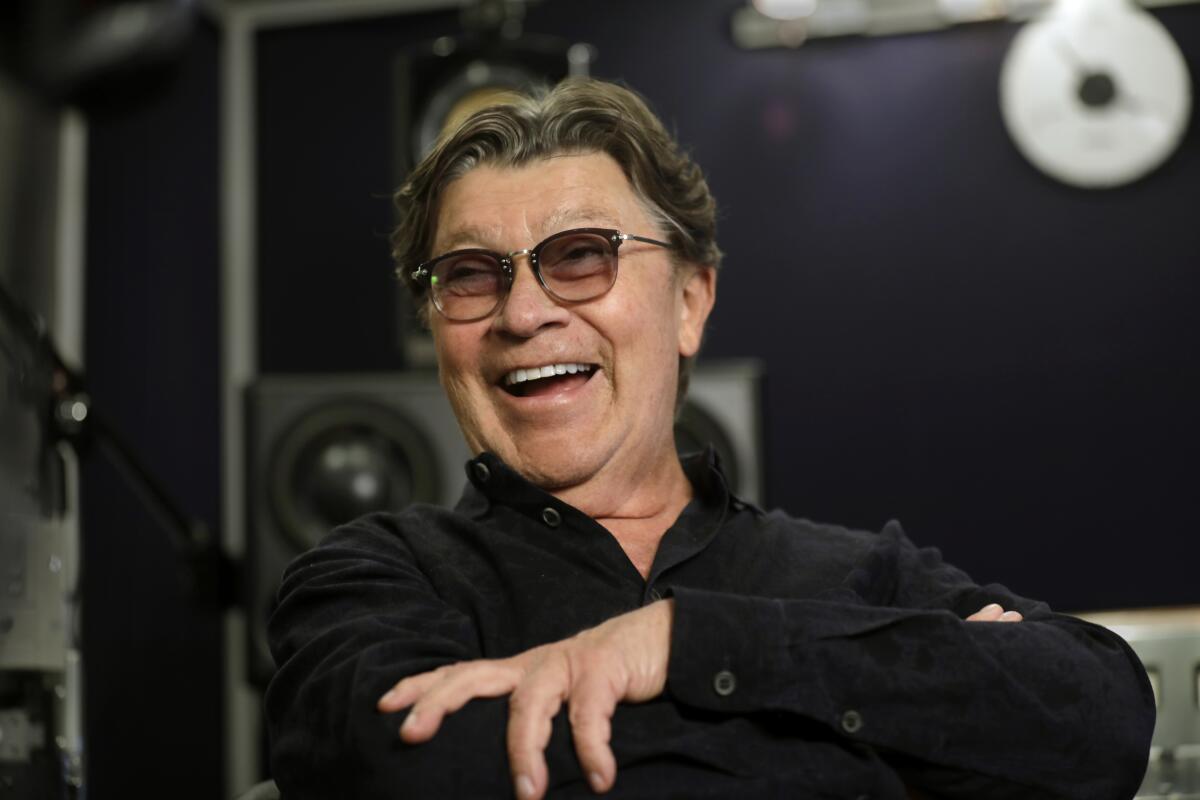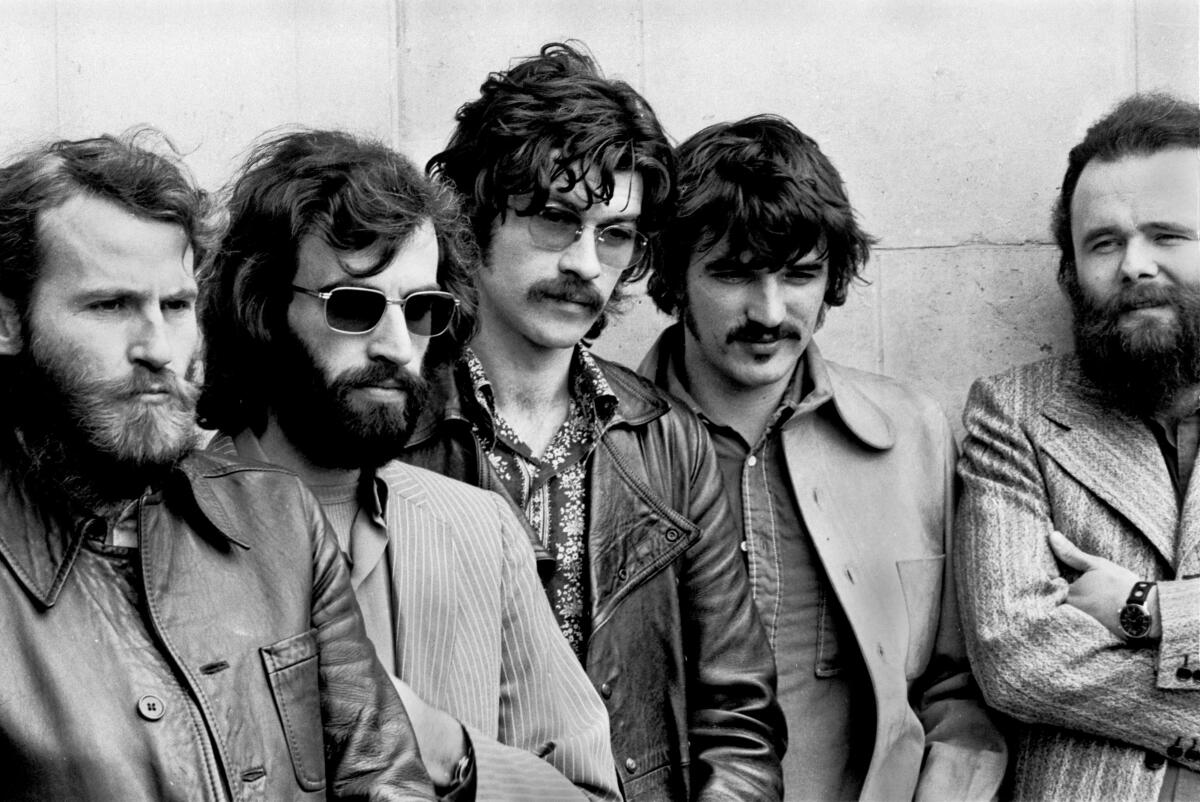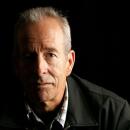The Band’s Robbie Robertson: My life in 12 songs

Robbie Robertson turned 76 in July, and could easily plead exhaustion now, given the startling number of projects coming to fruition for him as 2019 draws toward a close. Instead, sitting at the control board in his private recording studio in L.A on a recent afternoon, the man best known as co-founder and chief songwriter of the Band sounded positively energized about all the music he’s making.
“It’s the culmination of a lot of stuff that I was able to pull together,” he said, a confluence of endeavors that “took me into a dimension that I’ve never been before. One thing tends to inspire the other, and I was just able to go to some places on this record.”
For the record:
12:05 p.m. Nov. 7, 2019An earlier version of this post misidentified musician John Hammond Jr. as Bob Dylan’s A&R representative. That was Hammond’s father, veteran Columbia Records talent scout John Hammond Sr. It also identified the director of the new documentary “Once Were Brothers” as Martin Scorsese. It is directed by Daniel Roher.
“This record” refers to his first solo album in eight years, “Sinematic,” which has just been released. He also has extended his long-running collaboration with filmmaker Martin Scorsese with songs he’s written and recorded for the director’s latest feature, “The Irishman,” and is the subject of “Once Were Brothers,” a new biographical documentary directed by Daniel Roher and largely based on Robertson’s 2016 autobiography, “Testimony.”
He also has overseen a forthcoming 50th anniversary box set of the Band’s widely regarded second album, simply titled “The Band,” due Nov. 15. It comes on the heels of last year’s expanded edition of the group’s 1968 debut album, “Music From Big Pink.” Those recordings formalized the collaboration among Robertson and bandmates Levon Helm, Richard Manuel, Rick Danko and Garth Hudson, who previously had backed Bob Dylan — and were known then as the Hawks — on his plugged-in, scorched-earth tours of the U.S. and England in 1965 and 1966.
For this occasion, the Los Angeles Times asked Robertson to listen and respond to a selection of recordings that either influenced him or for which he was directly or indirectly responsible. They span more than 60 years, since he first picked up a guitar in his native Canada with dreams of following in the footsteps of such early rock ‘n’ roll heroes as Chuck Berry and Little Richard.
Robertson wasn’t told what he would be hearing. Songs were played essentially in chronological order while he listened, intently, at his studio’s control board.

1. Chuck Berry, “Brown Eyed Handsome Man” (1956)
“At the beginning of rock ‘n’ roll, ‘Brown Eyed Handsome Man’ stopped me in my tracks. There is a particular guitar sound on these early Chuck Berry records, and I thought, ‘What is that? How do you do that?’ Now, Gibson just made me a Chuck Berry Gibson 350 — it’s on the wall right there, that blond Gibson. [He points toward the glass partition, to one of about a dozen guitars hanging on the wall of the adjacent room.] That’s the exact guitar that we’re hearing here. No other guitar has that sound, and I got it. My son, Sebastian, presented it to me on Father’s Day. I don’t know what it is about that instrument, but that’s the one.”

2. Ronnie Hawkins, “Hey Boba Lou” (1959, one of two songs Robertson wrote as a teenager for Hawkins’ album “Mr. Dynamo”)
“They used [that] high voice [from the record’s opening] in ‘Once Were Brothers,’ with Ronnie Hawkins talking about when I was a young kid and he was contemplating hiring me. Early on, we were all learning other people’s music, and when I tried to learn to play the guitar part that Buddy Holly played on ‘Not Fade Away’ — a lot of people play it, but they don’t play it right — it was an instance where I thought, ‘Well, rather than learning somebody else’s song, it might be easier just to write a new one.’ ”

3. Johnny Cash, “The Ballad of Ira Hayes” (1964)
Robertson listens with eyes closed, waiting to speak until after the opening verse in which Cash sings: “Call him drunken Ira Hayes / He won’t answer anymore / Not the whiskey drinking Indian / Or the Marine that went to war.”
“Johnny Cash, boy, he was a song man — you know what I mean?” Robertson says. “You think, ‘Whoa, this guy not only has a sound, but he wants to say something when he sings, too.’ I loved story songs. Early records like [Jody Reynolds’ 1958 hit] ‘Endless Sleep’ — something like that just stood out, even in the folk-music scene. On the Band’s first album, I wanted to record ‘Long Black Veil’ because it was a story song.”

4. Bob Dylan & the Hawks, “Like a Rolling Stone” (live May 17, 1966, at Free Trade Hall, Manchester, England, the performance at which a fan shouted “Judas!” at Dylan just before he, Robertson and the Hawks performed this number)
Robertson closes his eyes and appears deep in thought during the first minute of the song.
“When Bob recorded the studio version of the song, I accidentally went with [musician] John Hammond Jr. to the studio. He said, ‘Oh God, I forgot, I promised my friend I would stop in, he’s recording,’ and I was like, ‘OK, whatever.’ We went in and they were recording ‘Like a Rolling Stone,’ and I thought, ‘Whoa, this guy’s pulling a rabbit out of the hat — I haven’t heard anything like this before.’ When I started playing with Bob, I didn’t know how so much vocal power could come out of this frail man. He was so thin. He was singing louder and stronger than James Brown [laughs]. We were in a battlefield on that tour, and you had to fight back.”

5. Bob Dylan & the Band, “Tears of Rage” (from “The Basement Tapes,” 1967)
Robertson’s hands are folded, his head turned to the left, as he listens to the song written by Dylan and the Band’s singer and keyboardist Richard Manuel, who also sings harmony.
“It was so much fun to see the look on Bob’s face when we played him ‘Music From Big Pink,’ and this is the first song on it. Starting your album with a long slow song was so against the rules, but when he heard what we did with this song, the look on his face — it was just priceless. He didn’t see this coming, and neither did anybody else. [Robertson pauses, listens to Manuel’s upper-register harmony.] That’s Richard singing that falsetto thing. You put it on and it takes you right to that place, you know?”

6. Roy Buchanan, “Sweet Dreams” (1972; the electric guitarist has been cited as key influence on Robertson’s signature style)
Robertson shakes his head during the introduction, lifts his chin, smiles and then nods as the instrumental unfolds for 90 seconds before he speaks.
“When I crossed paths with Roy [when Buchanan was sitting in with Hawkins’ band], I’d never seen anybody in my life who could do what he could do. A year before Chuck Berry passed away, I went to St. Louis and visited him and we went and had dinner, and after he was playing in a club. I’m sitting there and at one point I was staring at his hands and thinking, ‘Those are the hands that that sound came out of. It’s those hands. It’s that guitar too, but it’s those hands on that guitar.’ It’s the same thing with Roy. He was teaching me how to play a lick, and he played it, then said, ‘Here, here, try it!’ and he gave me his guitar. His guitar was unplayable for me. The strings were this high off the fretboard [separating his thumb and forefinger at least an inch] and it was like, I don’t even know what you’re doing, how to play this thing. It was like a different machine, a different instrument in his hands.”

7. Joni Mitchell, “Raised on Robbery” (featuring Robertson on lead guitar, from “Court and Spark,” 1974)
“Is this the most recent version of this? They remixed this record, you know. When they did, Joni said to me, ‘I listened to the whole song, and just listened to your guitar in it. The rhythm is incredible. And so when we remixed it, we turned it up.’ She and I have dinner every once in a while. [Robertson is asked whether they ever discuss their shared passion for painting — he created 13 original paintings to accompany each of the new songs on ‘Sinematic.’] She’s kind of in a different place right now, so when I hang out with her, I’m just visiting her and where she’s at right now. She’s gone through a lot, boy, so I just try to be there for her.”

8. Neil Diamond, “If You Know What I Mean” (from “Beautiful Noise,” produced by Robertson, 1976)
“That’s beautiful. I had great admiration for Diamond. When I decided I was going to make this record, a lot of people said, ‘Oh, no, you shouldn’t do this,’ and I was like, ‘I don’t agree.’ I admire the place that he comes from: It’s a long tradition of New York Jewish songwriters going back to Gershwin, Paul Simon, Billy Joel. ... He was carrying on this thing and taking it to a new place. This was no longer Irving Berlin; this was somebody now writing ‘Solitary Man.’ ”

9. Tom Petty, “The Best of Everything” (1984, co-produced by Petty and Robertson, with Richard Manuel and Garth Hudson)
At the stark piano introduction, Robertson bows his head, clasps his hands and rests his elbows on his knees as he leans forward to listen.
“This was an outtake, a song he’d left off a record, and I was putting together songs for [Scorsese’s 1984 film] ‘The King of Comedy.’ I kept his vocal but did something else with it. For him to have horns on a song … I didn’t mean to be disrespectful in replacing everybody [in the Heartbreakers] on it. But I was just hearing something else you could do with this.”

10. The Band, “Country Boy” (from “Jericho,” 1993, the first album from the group’s reconstituted lineup, minus Robertson. The plaintive song opens with one of the final recordings made by Manuel before he committed suicide in 1986.)
“Ahhhh. Heartbreaking. That’s quite a feeling, in a musical group, when there’s one guy in the group that when he does what he does, it just brings you to tears, and you almost think like, ‘Don’t do that — don’t do that! We’re trying to be strong over here. We’re trying to not show that kind of stuff.’ But Richard had that ability to just reach in and just grab you by the heart, in the most beautiful way.”

11. Billie Eilish, “Bad Guy” (2019)
“I went to the season opener this year of ‘Saturday Night Live.’ She was performing. I really like her, and I think this thing that she and her brother do is pretty magical. [Does he try to stay current with emerging talent?] I’m curious, yeah. But I like her more than many of the others.”

12. Robbie Robertson, “Once Were Brothers” (from “Sinematic,” 2019)
“Making this record was one of the most interesting musical endeavors I’ve ever had. That’s so gratifying to me at this stage, because you think that you’ve used up most of your tricks by now. A lot of people in my generation, some of them don’t write anymore, some of them can’t write anymore, and some of them do write, but it doesn’t matter that much. On this record, I was allowed [to do so much] because of what was going around in the universe, my universe.
I was working on ‘The Irishman,’ and that was influencing what I was doing. This documentary is going on, and because of the documentary I wrote this song and they were like, ‘Oh my God, we want to call the documentary this — this is like the soul of the emotion that we’re trying to get out of this thing,’ and I’m thinking ‘Wow, that’s great.’ I’m putting together the 50th anniversary of ‘The Band’ collection, and I want to reflect on this brotherhood.”
More to Read
The biggest entertainment stories
Get our big stories about Hollywood, film, television, music, arts, culture and more right in your inbox as soon as they publish.
You may occasionally receive promotional content from the Los Angeles Times.











